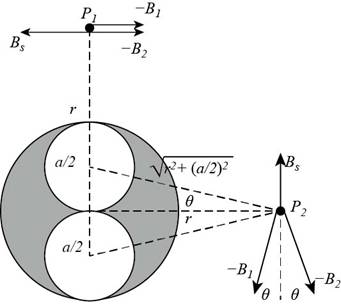
Concept explainers
(a)
The magnitude and direction of the magnetic field in terms of μ 0 I
r
a
P 1
(a)
Answer to Problem 30.75CP
Explanation of Solution
Given info: The given figure is shown below:

Figure (1)
Write the expression for the current in the solid conductor is,
Here,
Formula to calculate the net area of the conductor is,
Replace
Rearrange for
Write the expression for the area of the solid conducting part is,
Here,
Write the expression for the area of the cavity part is,
From the right hand rule, the current is directed out of the page so, the direction of magnetic field at point
Formula to calculate the magnetic field produces at point
Here,
Substitute
Formula to calculate the magnetic field produces at point
Substitute
Since both the cavities are of same hence the field will be same.
Formula to calculate the net magnetic field produces at point
Substitute
Substitute
Conclusion:
Therefore, the magnetic field in terms of
(b)
The magnitude and direction of the magnetic field in terms of μ 0 I
r
a
P 2
(b)
Answer to Problem 30.75CP
Explanation of Solution
From the right hand rule, the current is directed out of the page so, the direction of magnetic field at point
Formula to calculate the magnetic field produces at point
Here,
Substitute
Formula to calculate the magnetic field produces at point
Substitute
Since both the cavities are of same hence the field will be same.
Formula to calculate the net magnetic field produces at point
Substitute
Substitute
Conclusion:
Therefore, the magnitude of the magnetic field in terms of
Want to see more full solutions like this?
Chapter 30 Solutions
Physics for Scientists and Engineers, Technology Update (No access codes included)
- 20. Two small conducting spheres are placed on top of insulating pads. The 3.7 × 10-10 C sphere is fixed whie the 3.0 × 107 C sphere, initially at rest, is free to move. The mass of each sphere is 0.09 kg. If the spheres are initially 0.10 m apart, how fast will the sphere be moving when they are 1.5 m apart?arrow_forwardpls help on allarrow_forwardpls help on thesearrow_forward
- pls help on all asked questions kindlyarrow_forwardpls help on all asked questions kindlyarrow_forward19. Mount Everest, Earth's highest mountain above sea level, has a peak of 8849 m above sea level. Assume that sea level defines the height of Earth's surface. (re = 6.38 × 106 m, ME = 5.98 × 1024 kg, G = 6.67 × 10 -11 Nm²/kg²) a. Calculate the strength of Earth's gravitational field at a point at the peak of Mount Everest. b. What is the ratio of the strength of Earth's gravitational field at a point 644416m below the surface of the Earth to a point at the top of Mount Everest? C. A tourist watching the sunrise on top of Mount Everest observes a satellite orbiting Earth at an altitude 3580 km above his position. Determine the speed of the satellite.arrow_forward
- pls help on allarrow_forwardpls help on allarrow_forward6. As the distance between two charges decreases, the magnitude of the electric potential energy of the two-charge system: a) Always increases b) Always decreases c) Increases if the charges have the same sign, decreases if they have the opposite signs d) Increases if the charges have the opposite sign, decreases if they have the same sign 7. To analyze the motion of an elastic collision between two charged particles we use conservation of & a) Energy, Velocity b) Momentum, Force c) Mass, Momentum d) Energy, Momentum e) Kinetic Energy, Potential Energyarrow_forward
 Physics for Scientists and Engineers with Modern ...PhysicsISBN:9781337553292Author:Raymond A. Serway, John W. JewettPublisher:Cengage Learning
Physics for Scientists and Engineers with Modern ...PhysicsISBN:9781337553292Author:Raymond A. Serway, John W. JewettPublisher:Cengage Learning Principles of Physics: A Calculus-Based TextPhysicsISBN:9781133104261Author:Raymond A. Serway, John W. JewettPublisher:Cengage Learning
Principles of Physics: A Calculus-Based TextPhysicsISBN:9781133104261Author:Raymond A. Serway, John W. JewettPublisher:Cengage Learning Physics for Scientists and Engineers: Foundations...PhysicsISBN:9781133939146Author:Katz, Debora M.Publisher:Cengage Learning
Physics for Scientists and Engineers: Foundations...PhysicsISBN:9781133939146Author:Katz, Debora M.Publisher:Cengage Learning
 Physics for Scientists and EngineersPhysicsISBN:9781337553278Author:Raymond A. Serway, John W. JewettPublisher:Cengage Learning
Physics for Scientists and EngineersPhysicsISBN:9781337553278Author:Raymond A. Serway, John W. JewettPublisher:Cengage Learning College PhysicsPhysicsISBN:9781305952300Author:Raymond A. Serway, Chris VuillePublisher:Cengage Learning
College PhysicsPhysicsISBN:9781305952300Author:Raymond A. Serway, Chris VuillePublisher:Cengage Learning





